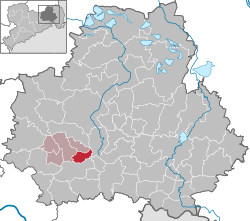Meissen is a district (Kreis) in the Free State of Saxony, Germany. It is bounded by the state of Brandenburg, the district of Bautzen, the urban district Dresden, the districts Sächsische Schweiz-Osterzgebirge, Mittelsachsen and Nordsachsen.

Böhlen is a town in the Free State of Saxony, Germany, south of Leipzig. Its main features are a small airport and a power-plant. It is located in the newly built Neuseenland, the lakes created in the former open-pit mining areas.

Bad Gottleuba-Berggießhübel is a spa town in the district Sächsische Schweiz-Osterzgebirge in the Free State of Saxony, Germany. The municipality borders the Czech Republic in the south. The municipality was formed on 1 January 1999 by the merger of the former municipalities Bad Gottleuba, Berggießhübel, Langenhennersdorf and Bahratal. Surrounded by forests and near a water dam Bad Gottleuba-Berggießhübel has several facilities, including a spa health park, a plant garden and a heated open air pool.

Bad Schandau is a spa town in Germany, in the Sächsische Schweiz-Osterzgebirge district of the Free State of Saxony. It is situated on the right bank of the Elbe, at the mouth of the valley of the Kirnitzsch and in the area often described as Saxon Switzerland.

Mittweida is a town in the Free State of Saxony, Germany, in the Mittelsachsen district.
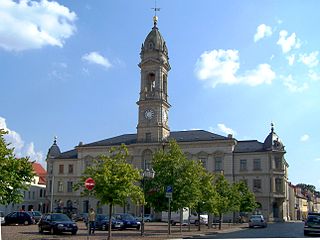
Großenhain is a Große Kreisstadt in the district of Meissen, Saxony, Germany. It was originally known as Hayne. The current name simply means "big Hayne"

Königstein is a town on the Elbe river in the Free State of Saxony in Germany. Königstein lies in the Sächsische Schweiz-Osterzgebirge District and had a population of 2,089 in 2018. It includes land on both banks of the Elbe, but the centre and most of the town lies to the south of the river. The Königstein Fortress is situated above and to the south-west of the town.
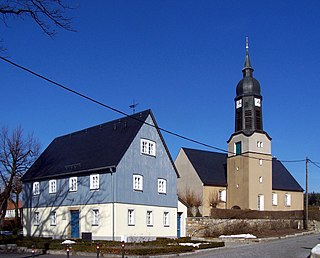
Haselbachtal is a municipality in the district of Bautzen in the Free State of Saxony, Germany with a population of 4,648. It consists of the villages Bischheim, Häslich, Gersdorf, Möhrsdorf, Reichenau, and Reichenbach.

Elsterberg is a town in the Vogtlandkreis district, in the Free State of Saxony, Germany. It is situated on the river White Elster, 6 km southwest of Greiz, and 13 km north of Plauen.

Groitzsch is a town in the Leipzig district, in Saxony, Germany.

Oederan is a town in the district of Mittelsachsen, in the Free State of Saxony, Germany.
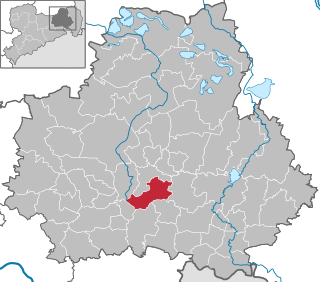
Burkau (German) or Porchow (Sorbian) is a municipality in the east of Saxony, in the district of Bautzen in Germany.
Oberlichtenau is a village and a former municipality in the district of Bautzen, in Saxony. Since 1 January 2009, it is part of the town Pulsnitz.
Räckelwitz (German) or Worklecy (Sorbian) is a municipality in Bautzen district, in the state of Saxony, Germany. The municipality of Räckelwitz has a population of 1,170 and is a member of the municipal association "Am Klosterwasser"(Zarjadniski zwjazk „Při Klóšterskej wodźe“).

Borsdorf is a municipality in the Leipzig district in Saxony, Germany.
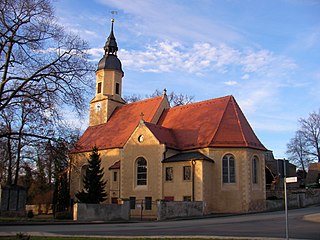
Glaubitz is a municipality in the district of Meißen, in Saxony, Germany. In the town there is a monument to the victims of the S.S.
Leipzig is a district (Kreis) in the Free State of Saxony, Germany. It is named after the city Leipzig, which is partly surrounded by the district, but not part of it. It borders the state Saxony-Anhalt, the urban district Leipzig, the districts Nordsachsen and Mittelsachsen, and the state Thuringia.
Mittelsachsen is a district (Kreis) in the Free State of Saxony, Germany.
Saxon Switzerland-Eastern Ore Mountains is a district (Kreis) in the Free State of Saxony, Germany. It is named after the mountain ranges Saxon Switzerland and Eastern Ore Mountains.

Pulsnitz or Połčnica is a town in the district of Bautzen, in the Free State of Saxony, Germany. It is situated on the small river Pulsnitz, 11 km southwest of Kamenz, and 24 km northeast of the centre of Dresden.

